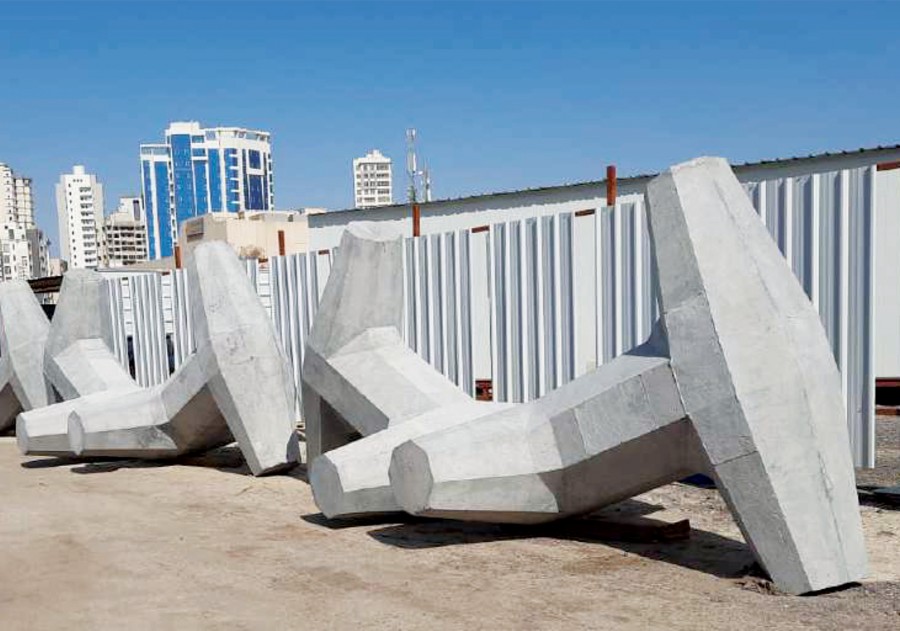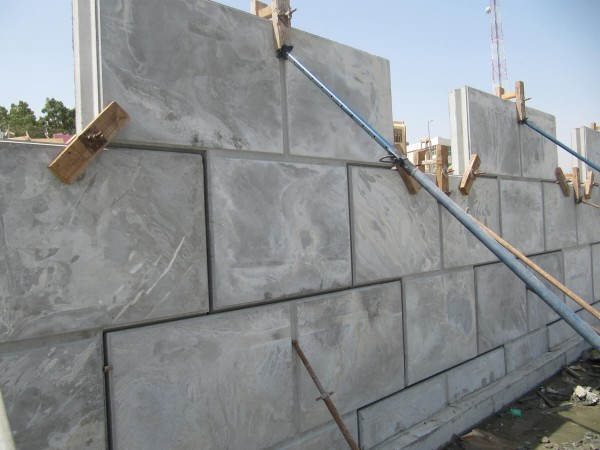Enhancing Precast Structures with GFRP Concrete Reinforcement

The use of glass fiber concrete reinforcement in precast structures like marina pontoons, tetrapods, and seawall panels has gained popularity due to their cost savings, endurance, and resistance to corrosion.
This article explores the utilization of GFRP concrete reinforcement in precast structures, highlighting their benefits.
The head of precast operations for the Dibba Harbor Seawall, calculated that the lightweight of GFRP reinforcement resulted in a 75% reduction in labor for rebar placement, significantly enhancing production efficiency and labor savings.
Advantages of GFRP Concrete Reinforcement for Precasting or Sitecasting
Using Mateenbar™ rebar in precast concrete offers several advantages. They exhibit resistance to corrosion, are lightweight, and demand minimal upkeep. Here are some key benefits:
-
Corrosion and Chemical Resistance: GFRP doesn't corrode, preventing concrete spalling and unsightly rust marks on the concrete surface.
-
Extended Design Life: Integrating GFRP rebar can extend the asset's lifespan by up to four times and decrease the need for costly maintenance.
-
Lightweight: GFRP weighs a quarter of steel for the same volume. This translates to faster installation, easier lifting for workers, and reduced transportation costs.
-
High Tensile Strength: GFRP possesses double the tensile strength of steel. Although it has a lower tensile modulus, which often affects the required rebar quantity, design codes, and standards help engineers adapt to these mechanical differences.
-
Simple Installation: GFRP is easily cut on-site using standard cutting tools.
-
Reduced Concrete Coverage: A major advantage of GFRP in precast concrete is its ability to save concrete. Unlike steel rebar that requires extra concrete to prevent corrosion, GFRP doesn't corrode or cause spalling. This allows for a lighter precast structure that can still handle heavy loads. In comparison to steel rebar, less concrete coverage is required when using Mateenbar™ GFRP rebar.
Precast Concrete Tunnel Segments Research from the University of Rome on precast tunnel segments reinforced with GFRP showed that using GFRP rebars is suitable when durability concerns could jeopardize tunnel integrity, such as aggressive environments or aggressive soils in wastewater tunnels. Opting for GFRP reinforcement over steel rebar can be especially beneficial similar applications.
Mechanical Performance and Behavior of GFRP Concrete Reinforcement
When using GFRP Concrete reinforcement structures, understanding their mechanical performance and behavior is crucial. GFRP reinforcement possesses distinct mechanical properties compared to steel, necessitating a different design approach. This is comprehensively covered in design codes like ACI-440.11-22, which guides design engineers through the process.
Utilizing GFRP Concrete Reinforcement in Precast Applications
The successful integration of Mateenbar™ reinforcement into precast concrete structures has been demonstrated through various case studies. Below are a few instances of precast applications showcasing the use of GFRP products:
-
Seawall Reconstruction, Sydney, Australia: In Botany Bay, prefabricated panels that exceeded their design life are now using Mateenbar™ in their precast panels to ensure a 100-year design life in a waterfront residential area. To mitigate the risk of corrosion that commonly occurs below the capping beam, the GFRP-reinforced seawall panels are strategically positioned in front of the current seawall structure. This placement serves a dual purpose: safeguarding the existing wall against future deterioration and enhancing the overall aesthetic appeal. The innovative GFRP-reinforced panels offer the distinct advantage of being impervious to rust and concrete breakage proving a long-lasting and sustainable solution.
-
Dibba Harbour Canal Seawall, UAE: Canal wall panels were produced at an on-site precast yard. The lightweight GFRP reinforcement led to a remarkable 75% reduction in labor for rebar placement, greatly boosting production efficiency.

Precast concrete panels for Dibba Harbour Canal
-
Post-earthquake Seawall, Kaikoura, NZ: The seawall foundations are positioned beneath the high tide threshold. The design takes into account potential sea level fluctuations, offering the flexibility for future adjustments to enhance the structure's elevation if required. The absence of steel reinforcement in this initiative serves a twofold purpose: ensuring an extended operational lifespan and attaining an economically efficient structure with a long lifecycle.
- Tetrapod projects, Kuwait and Saudi Arabia (pictured above): Mateenbar™ was used to reinforce tetrapods, cutting concrete coverage requirements and lowering labor and material costs. The utilization of GFRP also extends the lifespan of the tetrapods by preventing concrete spalling and corrosion risks.
Get in touch
If you are interested in Mateenbar™ concrete reinforcement, contact us.